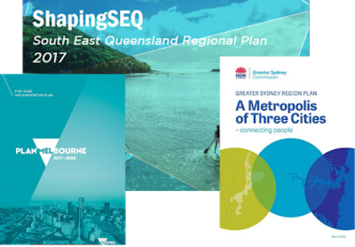
The global response to the impact of the Coronavirus seems consistent in at least one respect: everything we previously took for granted is now up for grabs. Long held truisms, established patterns of corporate and individual behaviour, doctrinal teachings, professional articles of faith – nothing is immune from Covid-19 induced change.
The immediate and long terms impacts are potentially going to reshape cities and the behaviours of the people who inhabit and work in them. Nothing seems untouched: from the nature of work and where it’s conducted, to urban mobility, immigration and population growth, housing preferences, retail spending and personal consumption. A more comprehensive shake up could not have been imagined only 6 months ago.
Many Australian cities and regions adopted regional planning policies built on some common themes around the mid to late 1990s – the curb of rapid outward expansion, policies of urban consolidation and infrastructure strategies designed to support these principles. Regional plans have been reviewed and updated since then but the general principles haven’t fundamentally changed. Then along came a virus, and it potentially changes everything. Persisting with the assumptions that underpin these regional plans, as if nothing has changed, now makes little sense. They need a root and branch rethink.
Central to many of these assumptions was a frenetic rate of population growth. In South East Queensland for example, the population was predicted to rise from 3.5 million in 2016 to 5.3 million by 2041 – a 50% increase in just 25 years. It took nearly 160 years to grow by 3.5 million but the next 2 million was forecast to come in 25 years. Melbourne and Sydney planned for similarly meteoric rates of growth. Those predicted rates of growth owe themselves entirely to Australia’s international immigration policies, which until Covid were running hot. That tap is now turned firmly off, and according to many is unlikely to be opened anywhere near as wide again.
Even traditionally woke pro-immigration Labor Party spokepeople like Kristina Keneally are now calling for curbs to protect Australian workers. “The post-COVID-19 question we must ask now is this: when we restart our migration program, do we want migrants to return to Australia in the same numbers and in the same composition as before the crisis? Our answer should be no,” she wrote in an opinion piece for the Sydney Morning Herald. Many Labor colleagues refuted her suggestion but it is clear that on both sides of politics, the idea of rapid immigration driving population growth is off the table for some time. As this underpinned many of the key assumptions and forecasts of regional plans, this aspect at least needs a completely fresh look at the implications.
That will also impact on assumptions around housing, deeply embedded in most regional plans; where it will be needed and what it will look. If patterns of settlement are going to change, and if housing preferences also change (as many seem to suggest) that will impact on everything from planning for schools, hospitals, and civil infrastructure. Demand for rural and semi-rural living could also change, as the attractions of ‘splendid isolation’ are not lost on people. The prospects for high density housing around high intensity transit nodes – transit-oriented development – is yet another dimension of the prevailing orthodoxy that Covid-19 could dramatically impact. Just shutting our eyes and pretending it won’t is not good strategy.
Read the rest of this piece at Finger on the Pulse Blogspot.
Ross Elliott has more than twenty years experience in property and public policy. His past roles have included stints in urban economics, national and state roles with the Property Council, and in destination marketing. He has written extensively on a range of public policy issues centering around urban issues, and continues to maintain his recreational interest in public policy through ongoing contributions such as this or via his monthly blog, The Pulse.












